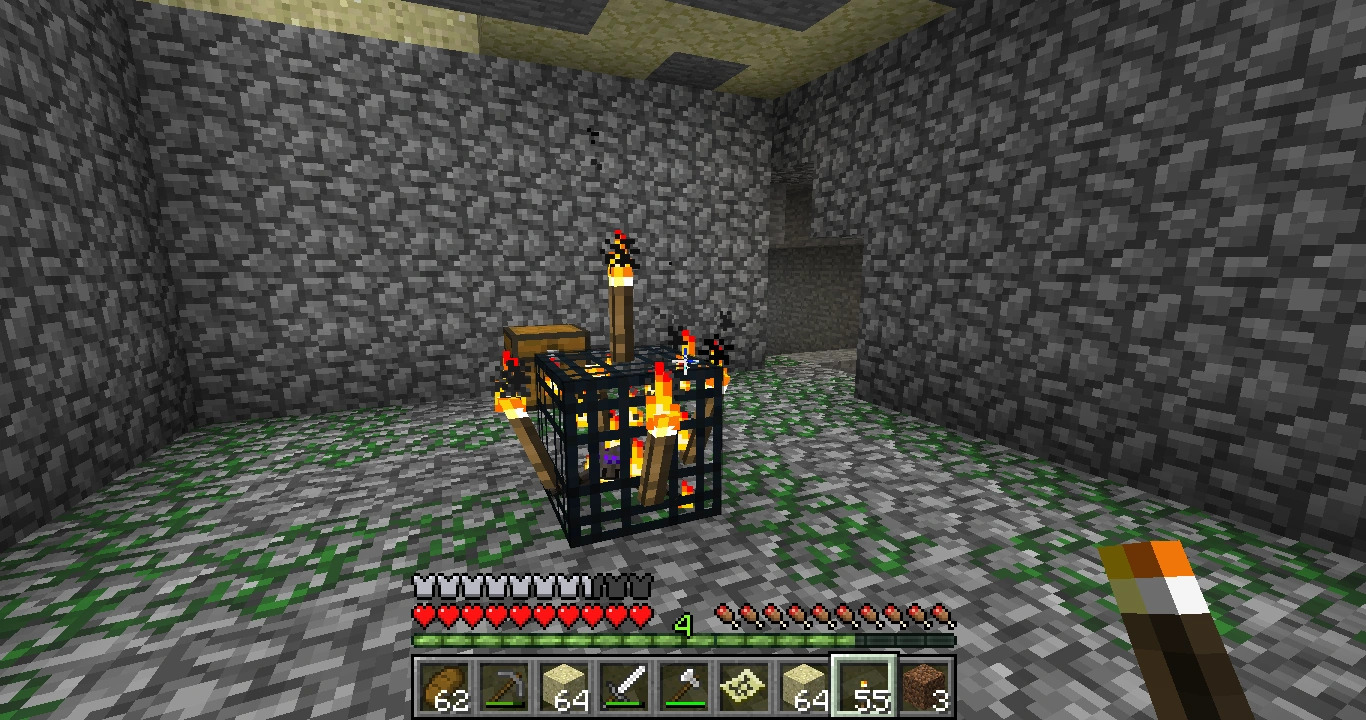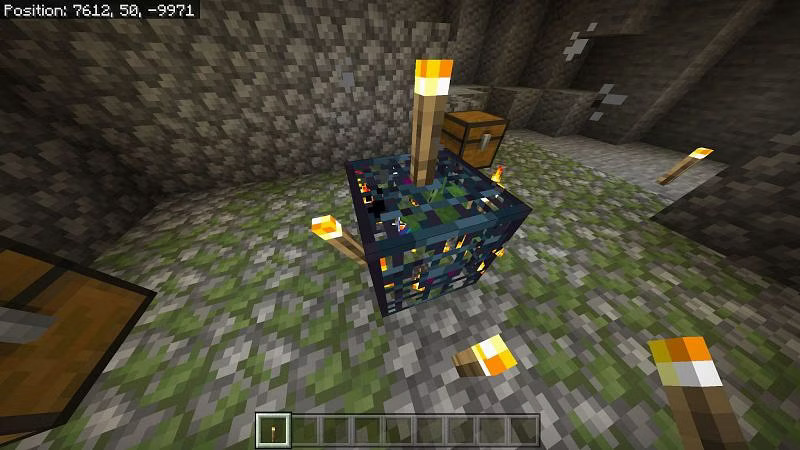Welcome to the adventurous realm of Minecraft, where the possibilities are as vast as the pixelated landscapes that stretch beyond the horizon. Within this blocky universe lies a hidden underworld teeming with secrets, dangers, and untold treasures: the dungeons of Minecraft. These enigmatic structures lurk beneath the surface, challenging players to embark on a quest of discovery and plunder.
The allure of exploring dungeons in Minecraft is undeniable. The thrill of uncovering the entrance to a hidden lair, the anticipation of facing formidable foes, and the promise of valuable loot waiting to be claimed all contribute to the excitement of this undertaking. In these subterranean chambers, players will find themselves confronting a myriad of challenges that test their skills, resourcefulness, and wit.
As a sandbox game, Minecraft encourages players to explore, create, and survive in a procedurally generated world. While the surface terrain offers its fair share of wonders and surprises, the real treasures lie beneath the ground. The secrets of Minecraft dungeons are spread across various biomes, from the icy tundras to the scorching deserts, and within the dark recesses of winding caves, abandoned mineshafts, and enigmatic ravines.
Listening to subtle cues can lead to hidden discoveries. The soft echoes of monsters, the faint rustling of unseen creatures, or the mysterious sounds resonating from the depths might all indicate the proximity of a dungeon. These tantalizing audio cues beckon players to delve further into the unknown, unearthing secrets that await them just out of sight.
Finding dungeons is an art that requires both patience and curiosity. The world of Minecraft is vast, and navigating its depths can be an overwhelming experience. However, equipped with keen observation and an adventurous spirit, players can uncover the most well-hidden dungeons.
For those seeking companionship and camaraderie, forming teams with like-minded adventurers can heighten the excitement and increase the chances of finding these elusive dungeons. The combined efforts and ingenuity of a group of players make the journey even more rewarding and memorable.
The rewards of discovering a dungeon are numerous and varied. From rare enchanting books that empower weapons and armor to exclusive items that showcase your prowess as a Minecraft explorer, each dungeon offers a unique and fulfilling experience.
So, prepare your tools, sharpen your senses, and embrace the unknown as we embark on an epic journey to reveal the secrets of Minecraft dungeons. The underground awaits, and the tales of your bravery and discoveries will echo through the virtual world of Minecraft for ages to come.
What is a Dungeon?

In the context of Minecraft, a dungeon is a type of generated structure that exists below the surface of the game world. It is a confined and often maze-like underground structure made up of stone bricks and cobblestone, containing multiple rooms and corridors.
Dungeons in Minecraft are notable for several key features:
- Monster Spawners: The heart of a dungeon is a monster spawner, a block that continuously spawns hostile creatures within a specific radius. The type of monster spawned depends on the dungeon’s location and can include zombies, skeletons, spiders, or other hostile mobs.
- Loot Chests: Scattered throughout the dungeon, players can find treasure chests containing valuable loot. These chests often contain items such as rare enchanting books, valuable ores, various materials, and even enchanted weapons and armor.
- Cobwebs: Cobwebs are commonly found within dungeons and can slow down or trap players. They are both a hindrance and an indicator that a dungeon might be nearby.
- Design Variations: Dungeons can have different themes, reflecting the biome they are found in. For instance, mossy cobblestone and vines might adorn dungeons in lush forests, while ice and packed ice might be present in icy tundras.
- Boss Room: Some dungeons feature a larger chamber at the end that houses a more powerful mob, often referred to as the “boss.” Defeating the boss can lead to even greater rewards.
Exploring dungeons can be a challenging and rewarding experience. Players brave enough to venture into these dark and dangerous places can test their combat skills against waves of monsters, seek valuable treasures, and collect rare items to enhance their Minecraft adventures.
It’s important to note that while dungeons can be found naturally generated in the game world, Minecraft also offers randomly generated “dungeon” structures when using the “/locate” command, but these structures do not contain spawners or loot chests. The true dungeons with spawners and loot are the naturally generated ones hidden below the surface, waiting to be discovered by brave adventurers.
Structure of a Dungeon

The structure of a dungeon in Minecraft follows a consistent pattern, though there can be some variations in design based on the biome and terrain features. Generally, a dungeon is an underground maze-like structure made primarily of stone bricks and cobblestone, with several key elements:
- Entrance: Dungeons are typically accessed through a single entrance, often a 1×2 or 2×2 hole in the ground. This opening leads players into the heart of the dungeon.
- Rooms and Corridors: Once inside, players will find a series of interconnected rooms and corridors. The layout can be maze-like, with twists and turns, making navigation challenging. Some dungeons may have larger, open rooms, while others may be more confined with tight passageways.
- Monster Spawners: The central feature of a dungeon is the monster spawner. These spawners are scattered throughout the structure and are responsible for continuously spawning hostile mobs within a certain range. The type of mob spawned depends on the biome and dungeon location.
- Loot Chests: Along the corridors and in some rooms, players will encounter loot chests. These chests contain valuable items, such as enchanted books, valuable ores, and rare equipment. The loot varies in quality, and players must brave the dangers of the dungeon to claim these rewards.
- Cobwebs: Cobwebs are often found throughout the dungeon. These slow players down when walked through and can obstruct pathways, adding to the challenge of navigating the dungeon.
- Trap Doors and Pressure Plates: Some dungeons may include traps such as trap doors or pressure plates that trigger mechanisms, releasing additional mobs or making parts of the floor give way, adding an element of surprise and danger.
- Boss Room: Some dungeons may have a larger, more elaborately designed room at the end, housing a powerful boss mob. Defeating the boss usually yields even greater rewards and serves as a thrilling climax to the dungeon exploration.
It’s important to note that dungeons are randomly generated during world creation and may differ in size and complexity. Some dungeons may be relatively small and easy to conquer, while others may sprawl across multiple rooms and present a more formidable challenge.
Overall, the structure of a Minecraft dungeon is designed to offer players a sense of adventure, mystery, and danger as they explore the depths of the game world, face hostile creatures, and seek out valuable treasures.
Dungeon Mobs and Loot
In Minecraft dungeons, players can encounter a variety of hostile mobs and find valuable loot as they explore these underground structures. Here’s an overview of the mobs and loot commonly found in dungeons:
Dungeon Mobs:
- Zombies: These slow-moving undead creatures are a staple in dungeons. They can be armed with various weapons, making them more dangerous. Zombies often drop rotten flesh upon defeat.
- Skeletons: Equipped with bows and arrows, skeletons can shoot from a distance, making them formidable foes. They drop bones and arrows upon defeat.
- Spiders: These arachnids can crawl on walls and have the ability to inflict players with the poison effect. Defeating spiders yields spider eyes and string.
- Creepers: Though not as common as other mobs, creepers can still appear in dungeons. When defeated, they drop gunpowder.
- Silverfish: These small and pesky creatures can emerge from certain blocks in the dungeon, and they drop experience points when defeated.
- Cave Spiders: Similar to regular spiders, cave spiders can inflict players with poison. They drop spider eyes and string.
- Blazes: Found in Nether-themed dungeons, blazes shoot fireballs at players. They drop blaze rods.
- Endermen: In End-themed dungeons, players might encounter endermen. They drop ender pearls.
Dungeon Loot:
- Enchanted Books: Dungeons often contain loot chests with enchanted books, which can grant powerful enchantments to weapons, tools, and armor.
- Valuable Ores: Some loot chests may contain rare ores like diamonds, emeralds, and even ancient debris (found in Nether-themed dungeons).
- Name Tags: Name tags are rare items used to name tamed pets and mobs. They are highly sought after and can be found in some dungeon chests.
- Music Discs: Some dungeon loot chests may contain rare music discs that play various tunes when placed in a jukebox.
- Horse Armor: In some dungeons, players may discover horse armor, which can be equipped to protect and style their tamed horses.
- Golden Apples: These valuable food items can provide powerful buffs, and players can find them in some loot chests.
- Saddles: Saddles can be found in dungeons and used to ride and control pigs, horses, and other mountable mobs.
Remember that the loot found in dungeons can vary, and not every dungeon will have the same items. Additionally, dungeons with bosses at the end may offer even more valuable and unique rewards for those brave enough to face the challenges and emerge victorious.
Odd Placements
In Minecraft, sometimes players may encounter odd or unusual placements of structures or features, including dungeons. These occurrences are a result of the game’s procedural generation and can lead to unique and unexpected scenarios. Here are a few examples of odd placements in Minecraft:
- Surface Dungeons: While dungeons are typically found underground, occasionally, they generate close to the surface, partially exposed to the open air. This odd placement can make them more accessible but also leaves them vulnerable to natural elements and players’ accidental discovery.
- Floating Dungeons: In rare cases, dungeons might generate suspended in the air, with no connection to the ground. These floating dungeons create intriguing visuals but may require creative solutions to access or explore them.
- Dungeon Staircases: Occasionally, dungeons can generate with long staircases leading down to their spawners and loot chests. These winding staircases can add a touch of mystery and suspense to the exploration process.
- Dungeons in Ocean Biomes: Dungeons can spawn underwater in ocean biomes, leading to partially flooded structures and unique underwater exploration challenges.
- Dungeons Inside Other Structures: Sometimes, dungeons generate inside or beneath other generated structures, such as villages, temples, or mineshafts. This overlap can create interesting and complex environments for players to navigate.
- Nearby Dungeon Clusters: It’s possible for multiple dungeons to generate relatively close to one another, forming clusters that offer even more opportunities for exploration and loot gathering.
- Sparse Loot Distribution: While loot chests are common in dungeons, there might be instances where a dungeon generates with very few or no loot chests, resulting in less rewarding expeditions.
- Extremely Large or Small Dungeons: While most dungeons have a moderate size, there are instances of dungeons generating much larger or smaller than usual, making for either grand or compact adventures.
It’s important to remember that Minecraft’s procedural generation system is designed to provide a diverse and dynamic world, and these odd placements contribute to the game’s charm and surprise factor. Players should embrace these quirks as they add a sense of unpredictability to their exploration journeys, making each experience in Minecraft truly one-of-a-kind.
Conclusion!
In conclusion, finding dungeons in Minecraft is a thrilling and rewarding endeavor that adds an element of mystery and excitement to the game. While the process of locating these underground structures may seem daunting at first, with the right approach and tools, players can enhance their chances of success. To discover dungeons, venture into different biomes, explore caves, ravines, and abandoned mineshafts, as dungeons can be hidden beneath the surface in various terrains.










